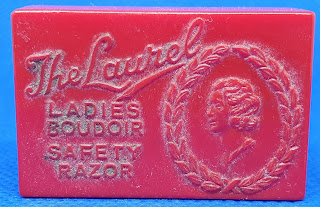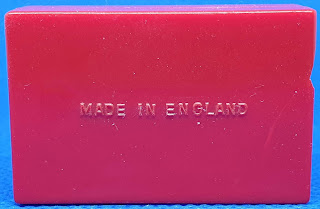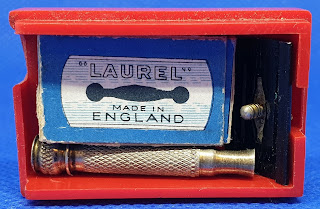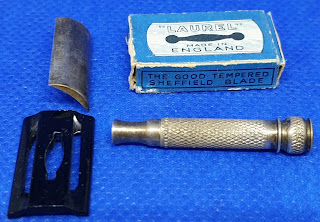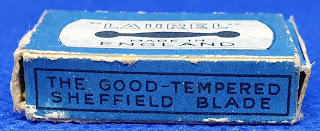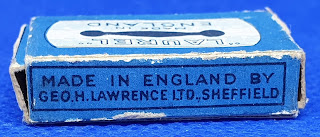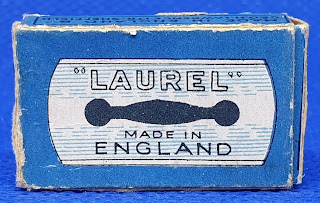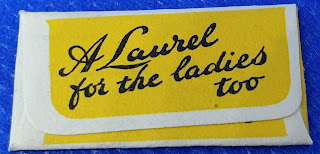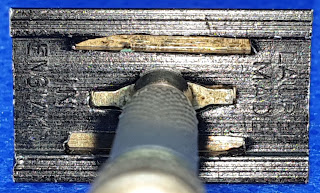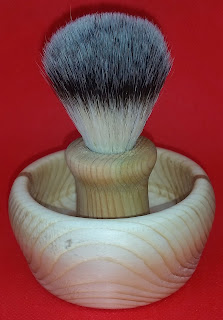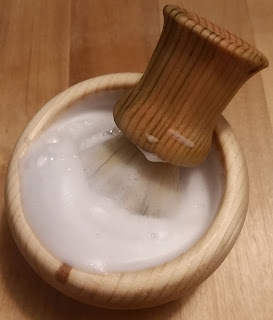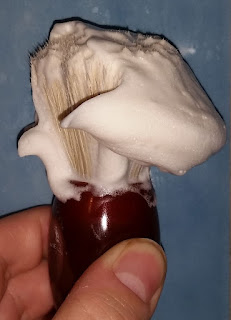Did y’all really have to travel to the dessert to shoot that advertisement?
Tag Archives: Thoughts while shaving
The most adorable DE: Laurel Ladies Boudoir Razor, with known provenance
My beloved wife seems to think that miniature versions of things are cute and adorable. With that in mind, the Laurel Ladies Boudoir Razor must be the most adorable DE ever.
Waits – in his excellent Razor Compendium – have the following to say about this razor:
Laurel Ladies Boudoir Razor
George H Lawrence, Limited, Sheffield, England. Small “Ladies Boudoir” double-edged safety razor and special blades in metal lithographed tins and plastics cases.
The razor itself is indeed small – as can be seen from the photos – and the blades are downright tine. The design seems to be a scaled down version of the Laurel “Dumb Bell” Razor from 1934, which sort of gives a lower end to when the Ladies Boudoir was manufactured. There is some indications online that the Ladies Boudoir was meant as an cosmetic razor, ie.: for trimming eyebrows and removing unsightly hairs, rather than for shaving armpits and the like.
My Ladies Boudoir came to me via a friend of the family, after he died several years ago – the same source as my EverReady 1914.
According to what I know, he picked it up in England during the War (World War Two, that is) and carried it in his pocket when he parachuted into Nazi occupied Norway as a commando/resistance fighter/saboteur – what we today would likely identify as a Special Forces Operator. The idea behind bringing it was that if he got separated from his equipment – which was dropped in a separate container – he would be able to make his way to a civilised area, and give himself a shave before contacting anyone so he wouldn’t immediately give himself away as one of the “boys in the forest” (a commonly used term for the Norwegian Resistance).
As luck would have it, he didn’t get away from his gear and the other resistance fighters was on the agreed upon meeting spot, so the razor sat unused in his pocket until the end of the war, and then among his mementos until it made it’s way to me.
As can be seen from the photos, the blade – and thus the razor’s head – is about ¼ of the size of a “real” DE razor. The handle is equally diminutive, and feels too thin to control in my hands at least. A nimble lady – or a WW2 Norwegian Commando whom on occasion disguised himself as a young teen – might find it easier to use than I would. My calipers gives the total length of the assembled razor as 38.3mm (1.5″), while the head measures 21.6mm by 12.8mm (0.85″ by 0.52″) – so either you go by looks of by the numbers, this is a tiny razor.
The Ladies Boudoir is of all metal construction; some online sources suggest that the base cap should be made of plastic or Bakelite, but from the wear and tear it’s plain that the one I inherited at least have a metal base with a black coating.
While it’s not my oldest razor, nor a razor I’ll ever actually use, the Laurel Ladies Boudoir is one of the last razors I own that I’ll ever give up. The history and provenance of it makes it beyond priceless to me.
Simple pleasures
Cold water on the face.
Krampert’s Finest Bay Rum.
I’m ready to face the world.
More playing with lathe – making of a small vase
Small homemade spruce shaving bowl
An hour on the lathe to get out of the way yielded a small spruce shaving bowl. Started with some leftover 2×4, finished with mineral oil and two coats of superglue finish.
It’s tested and working well for lathering. It’s admittedly a bit on the tiny side, but when you start with a 2×4 it’s a limit to how wide it can be without spending the time to glue up a blank.
Walled gardens, and how they apply to shaving
A lot of modern shave gear can be seen as part of a walled garden; a term most often used around computers that describe a closed platform where a single entity (provider) has control over applications, content, and media, and restricts convenient access to non-approved applications or content.
If you’re shaving with a cartridge razor, in theory at least you have to get your blades from the same guys who sold you the handle – and often not all of their cartridges fits all of their handles either. You can’t stick a Sensor Excel cartridge on a Mach3 or Fusion5 handle, and you certainly can’t expect a Schick cartridge of any kind to fit on any Gillette handle.
Unless you’re buying more handles, you’re locked to one brand and (in theory at least) one vendor. And given how hard some of those vendors advertise their canned goo and other shaving accoutrements, I get the feeling they would make their razors incompatible with their competitors canned goo if they could…
Yes, you’re getting a unified and consistent experience. Some users value and appreciate that, and I’m cool with the fact that they do. It don’t chance the underlying fact that cartridge razors is a series of closed platforms designed to make the end user dependent on the OEM.
Traditional safety razors on the other hand are open platform solutions. Yes, there is a number of distinct, non-compatible platforms; DE, SE, injectors and so on. But I can pick up any DE razor from a large number of wildly different manufacturers and be confident that any DE blade I buy will fit and work in the razor – same as any razor made for the GEM blade will take any GEM blade I can buy.
The underlying standards are open and accessible to all – anyone with the skills, drive and money can make and sell razors or blades. Since the patents are long expired, traditional wetshaving is in essence Open Source Hardware, with all the benefits (and drawbacks) that entails.
I’m not saying traditional safety razors are inherently better than cartridge razors. I’m saying they are inherently more open in this day and age, and to me that is an important thing.
No real content, but a reminder of a 15% off code
No shaving related blog post today – real life getting in the way again.
I did find the time this morning to order more of The Lavish Gentleman’s Natural Strength Oil Cleanser – read my review of it here – since it has firmly entrenched itself in my daily routine. You can still get 15% off by using the code WegianWarrior15, and for now at least they are also offering free shipping (yes, even to Europe!). Read the review, and consider trying it yourself. I’m confident you’ll like it.
An upcoming project
1800 blogposts and a lather shot
I just realised that this is the 1800th post on my blog… I mean, it shouldn’t be too surprising, since five posts a week for almost seven years adds up. Still, it’s a nice almost-round number to reach.
This is yesterdays lather – Krampert’s Finest Bay Rum Acadian Spice Shaving Soap on a VieLong #12705B natural white horse brush – after the third pass. Love how creamy and stiff it turned out, and the fact that is didn’t collapse at all.
Bessegg razor – made in Norway during the War
A lot of Norwegian Museums is part of what they call “The Digital Museum”, where you can search and browse the collections without having to actually go to a museum you didn’t even know existed in the first place.
The first Norwegian!
A new (torn word – perhaps ‘product’?)
The Besegg razor have a smooth protecting edge instead of the normal teeth.
The protective edge provides a perfectly efficient safety.
Under the drawing:
BESEGG RAZOR
A BETTER SHAVE
Left side of the table:
ADVANTAGES
1. Better, easier, more comfortable shaves
2. Greater safety
3. Easier cleaning
4. Solid, exact and beautiful construction
5. Made in Norway
Right side of the table:
PRICES
Sports model – 5 kroner
Standard model – 6 kroner
Gift model #1 – 10 kroner
Gift model #2 – 12 kroner
For the normal style of razor blades
Bottom:
THE RAZOR WITHOUT TEETH
The very small print:
Printed at Fabritius, Oslo / Besegg Manufacture Inc., Oslo
I’m fairly convinced the actual razor was a knock off or a near copy of a foreign design, or a chimera of different design elements from foreign razors.
5 kroner back in ’44 would be the equivalent of about 112 kroner today, or about 13.25 USD. However; the average yearly income was – according to my sources – 4260 kroner, so the cheapest model would cost 0.12% of your yearly income… not a small amount when you do the math.
Sidebar / fun factoid: Fabritius was a long established printer in Oslo, operating from 1844 to 1991.

